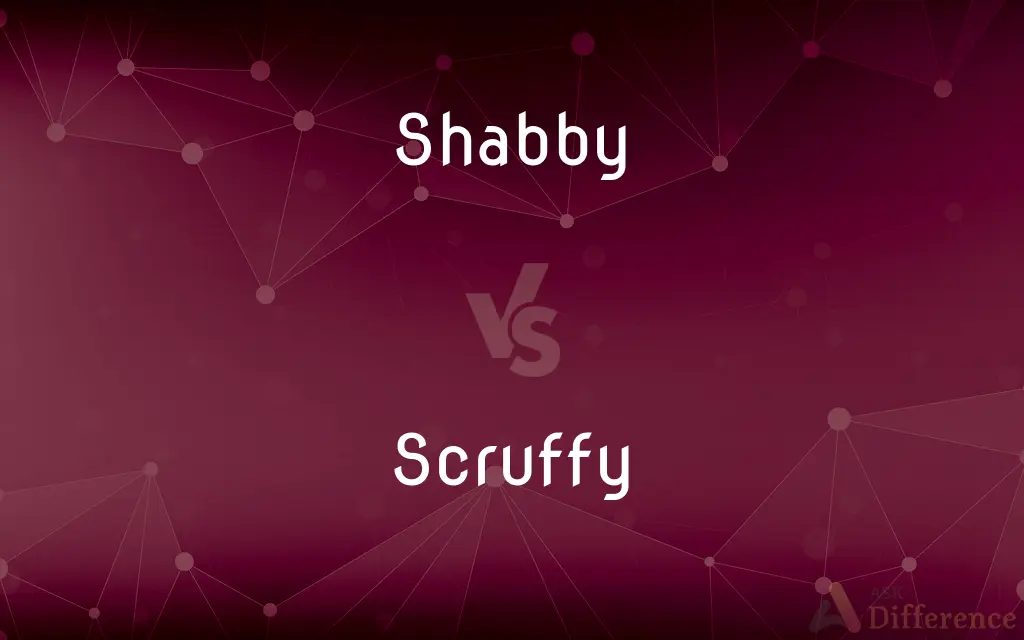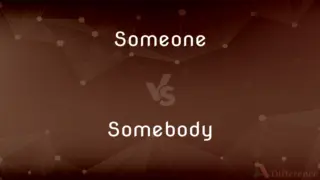Shabby vs. Scruffy — What's the Difference?
Edited by Tayyaba Rehman — By Urooj Arif — Updated on April 26, 2024
Shabby refers to worn-out and old appearance due to neglect, whereas scruffy denotes a generally unkempt or disheveled appearance.

Difference Between Shabby and Scruffy
Table of Contents
ADVERTISEMENT
Key Differences
Shabby often relates to objects and clothing that show signs of wear and age, often suggesting neglect or long-term use, while scruffy typically describes a person's overall messy or untidy appearance.
Shabby items may have faded colors and frayed edges, whereas scruffy can involve messy hair or unclean clothing.
Shabby suggests a decline from a previously better state, implying something was once of good quality but has deteriorated, on the other hand, scruffy may not imply any change from a previous state.
Shabby is frequently used in reference to material things like clothing, furniture, or buildings, whereas scruffy is more often applied to animals and humans.
While shabby has connotations of thinness and being worn out, scruffy is more about lacking in cleanliness or neatness.
ADVERTISEMENT
Comparison Chart
Definition
Showing signs of wear and tear
Appearing unkempt and disordered
Typical Use
Clothing, furniture, buildings
Hair, clothing, personal appearance
Connotation
Worn out from use, often looking old
Messy, often implying lack of grooming
Change Implication
Indicates deterioration from former state
May not suggest any change from baseline
Associated with
Material objects
Mainly humans or animals
Compare with Definitions
Shabby
Inferior in quality or condition.
He wore a shabby coat that barely kept him warm.
Scruffy
Unkempt in appearance.
His scruffy beard made him look older than he was.
Shabby
Reflecting a lack of care or maintenance.
The library's shabby books were rarely borrowed.
Scruffy
Disheveled or messy.
Her hair was scruffy after the long flight.
Shabby
Of modest or low condition.
They started their business in a shabby little office.
Scruffy
Casual and slightly ragged.
He showed up in scruffy jeans and a t-shirt.
Shabby
Appearing neglected or dilapidated.
The shabby house stood out in the well-kept neighborhood.
Scruffy
Showing a lack of care or neatness.
The dog’s scruffy fur needed grooming.
Shabby
Worn and tattered from age or use.
The chair's shabby upholstery needed replacing.
Scruffy
Rough around the edges.
The scruffy neighborhood was known for its vibrant street art.
Shabby
Showing signs of wear and tear; threadbare or worn-out
Shabby furniture.
Scruffy
Shabby and untidy or dirty
A teenager in scruffy jeans and a baggy T-shirt
Shabby
Dilapidated or deteriorated in condition, especially through neglect; seedy
A shabby little park.
Scruffy
(of a man's face) having short, bristly hairs as a result of not having been shaved for a while
His employer has got used to seeing his face becoming scruffier each spring
Shabby
Wearing threadbare clothing.
Scruffy
Shabby; untidy.
Shabby
Despicable; mean
A shabby trick.
Scruffy
Chiefly British Scaly; scabby.
Shabby
Not generous or just; unfair
Shabby treatment.
Scruffy
Untidy in appearance.
A scruffy little dog came scampering down the road.
Scruffy clothes
Scruffy man
Scruffy outfit
Shabby
Of mediocre or substandard quality.
Scruffy
Scurfy.
Shabby
(of clothing) Torn or worn; unkempt.
They lived in a tiny apartment, with some old, shabby furniture.
Scruffy
(informal) An artificial intelligence researcher who believes that intelligence is too complicated (or computationally intractable) to be solved with the sorts of homogeneous system favoured by the "neats".
Shabby
(of a person) Wearing ragged, very worn, or dirty clothing.
The fellow arrived looking rather shabby after journeying so far.
Scruffy
Shabby and untidy;
A surge of ragged scruffy children
He was soiled and seedy and fragrant with gin
Shabby
Mean; despicable.
Shabby treatment
Shabby
Poor; showing little effort or talent.
His painting is not too shabby.
Shabby
Torn or worn to rage; poor; mean; ragged.
Wearing shabby coats and dirty shirts.
Shabby
Clothed with ragged, much worn, or soiled garments.
Shabby
Mean; paltry; despicable; as, shabby treatment.
Shabby
Showing signs of wear and tear;
A ratty old overcoat
Shabby furniture
An old house with dirty windows and tatty curtains
Shabby
Mean and unworthy and despicable;
Shabby treatment
Common Curiosities
Can people be described as shabby?
Yes, people can be described as shabby if their clothing or appearance looks old, worn, or neglected.
How can I improve a shabby appearance?
Improving a shabby appearance can involve repairing, cleaning, or replacing items that are worn out or old.
What is the difference between scruffy and sloppy?
Scruffy generally refers to being unkempt or disheveled, mainly in terms of appearance, while sloppy can also include behavior and the manner of doing things.
Are shabby and shoddy the same?
No, shabby refers to appearance due to wear or age, while shoddy implies poor quality and craftsmanship.
What is the root of the word 'shabby'?
The word 'shabby' comes from the Old English "sceabb," meaning "scab," metaphorically used to describe something of poor quality.
What does shabby chic mean?
Shabby chic refers to a style that embraces aged furniture and other items that are characterized by signs of wear and distress, giving them a vintage, antique look.
Is scruffy always negative?
While often used negatively, scruffy can also convey a sense of casualness or rugged charm in certain contexts.
What kind of maintenance can prevent a scruffy appearance?
Regular grooming, proper attire, and general cleanliness can help maintain a neat appearance and prevent looking scruffy.
Can a place look scruffy?
Yes, places can look scruffy if they are not well-maintained or if they appear disorderly and untidy.
Does scruffy have a positive connotation in any context?
In casual or informal settings, scruffy can be seen as a style choice that suggests a laid-back or non-conformist attitude.
Share Your Discovery

Previous Comparison
Reed vs. Rush
Next Comparison
Someone vs. SomebodyAuthor Spotlight
Written by
Urooj ArifUrooj is a skilled content writer at Ask Difference, known for her exceptional ability to simplify complex topics into engaging and informative content. With a passion for research and a flair for clear, concise writing, she consistently delivers articles that resonate with our diverse audience.
Edited by
Tayyaba RehmanTayyaba Rehman is a distinguished writer, currently serving as a primary contributor to askdifference.com. As a researcher in semantics and etymology, Tayyaba's passion for the complexity of languages and their distinctions has found a perfect home on the platform. Tayyaba delves into the intricacies of language, distinguishing between commonly confused words and phrases, thereby providing clarity for readers worldwide.
















































